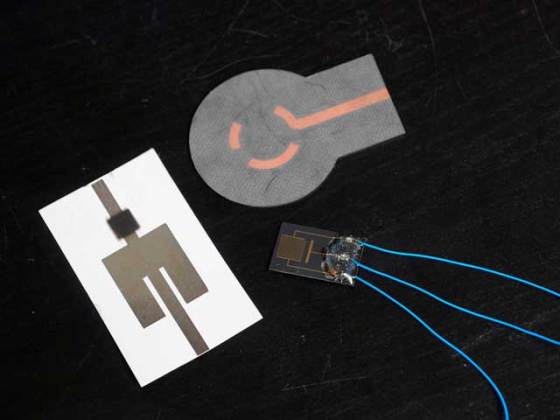Paper-based wireless sensor can detect explosive devices
 Researchers at the Georgia Institute of Technology have developed a prototype wireless sensor capable of detecting trace amounts of a key ingredient found in many explosives. The device employs carbon nanotubes printed on paper or paper-like material by using standard inkjet technology, and it could be deployed in large numbers to alert authorities to the presence of explosives.
Researchers at the Georgia Institute of Technology have developed a prototype wireless sensor capable of detecting trace amounts of a key ingredient found in many explosives. The device employs carbon nanotubes printed on paper or paper-like material by using standard inkjet technology, and it could be deployed in large numbers to alert authorities to the presence of explosives.
A resonant lightweight antenna, which is uses as the wireless component for communicating the sensor information, was printed on photographic paper using inkjet techniques developed by Professor Manos Tentzeris of Georgia Tech’s School of Electrical and Computer Engineering. The same inkjet techniques used to produce RF components, circuits and antennas can also be used to deposit the functionalized carbon nanotubes used for sensing.
Aside using of heavy photographic paper or plastics to make these components more water resistant, the inkjet component printing can also use flexible organic materials. For example, liquid crystal polymer (LCP) can be used to increase robustness and weather resistance. The resulting components are similar in size to conventional components but can conform and adhere to nearly any surface.
The “ink” contains silver nanoparticles in an emulsion that can be deposited by the printer are used to print components, circuits and antennas at relatively low temperatures around 100°C (212°F). A process called sonication helps to achieve optimal ink viscosity and homogeneity, enabling uniform material deposition and permitting maximum operating effectiveness for paper-based components. The optimization and fabrication of the system, as well as the tests for detection sensitivity were conducted by Xiaojuan (Judy) Song, a Georgia Tech Research Institute (GTRI) research scientist.
“The optimized carbon nanotubes are applied as a sensing film, with specific functionalization designed for a particular gas or analyte”, said Song. “The GTRI sensor detects trace amounts of ammonia usually found near explosive devices, and it can also be designed to detect similar gases in household, healthcare and industrial environments at very low concentration levels.”
These nanoscale cylindrical structures, with a diameter as small as the 1/50,000th width of a human hair in diameter, are coated with a conductive polymer that attracts ammonia. According to researchers, the sensor has been designed to detect ammonia in trace amounts which are as low as five parts per million. Such sensitivity combined with RF technology, enable standoff detection – identification of explosive materials at a relatively safe distance.
The wireless sensor nodes require relatively low power, which could come from a number of technologies including thin-film batteries, solar cells or some other sort of energy-harvesting techniques. GTRI researchers are also investigating ways to make the sensor operate passively, without any power consumption.
“We are focusing on providing standoff detection for those engaged in military or humanitarian missions and other hazardous situations”, said Krishna Naishadham, a principal research scientist who is leading the work at the GTRI. “We believe that it will be possible, and cost-effective, to deploy large numbers of these detectors on vehicles or robots throughout a military engagement zone.”










Leave your response!